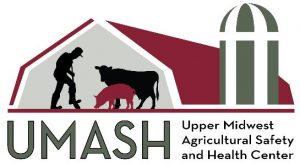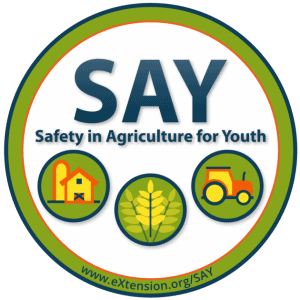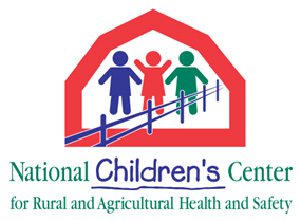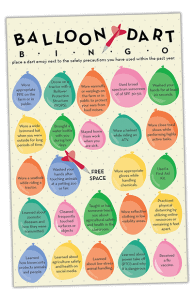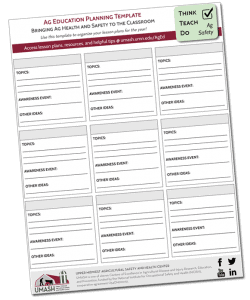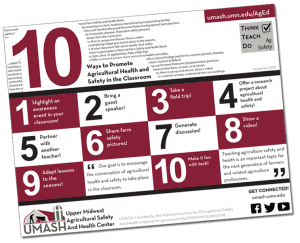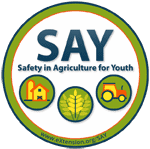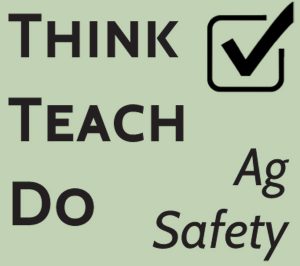
Teaching agriculture safety and health is an important topic for the next generation of farmers and related agriculture professions.
To assist teachers incorporating agricultural safety and health, UMASH has compiled a list of resources that can be used during the academic school year, such as: lesson plans, awareness events and additional resources to integrate health and safety topics into the classroom in a teacher friendly format. While not an exhaustive list, these resources cover many safety aspects related to agriculture and include tips on how to use the material in the classroom.
If you have questions or suggestions for additional teaching resources, please contact us:
Email: umash@umn.edu
Phone: 612-625-8836
EDUCATOR RESOURCES
FARM SAFETY BINGO
Here’s a fun activity for students of all ages. What safety practices have you completed in the past year? Can you get five in a row? Share your card on social media, tagging @UMASHcenter
SAMMY THE SAFETY CAN ACTIVITY BOOKLET
Join Sammy the Safety Can on an exciting adventure to teach youth about gasoline safety with this fun coloring and activity booklet! Funded by Central States Center for Agricultural Safety and Health NIOSH and The Legacy of Christopher Allsup Foundation, Inc.
AG SAFETY AND HEALTH TOPICS
Agritourism involves hosting on farm events for the public to attend, like petting zoos and apple orchards.
- Farm Safety Check: Agritourism
- Agritourism FFA Survey Infographic 2018
- Agritourism FFA Survey Infographic 2020
- UMASH Agritourism Playlist
- UMASH Handwashing and Agritourism Posters (English & Spanish)
- Integrating Safety Into Agritourism
- Safer Farm Animal Contact Exhibits (Safer FACEs) – FREE Online Training Program
- Zoonotic Disease Resource Repository for Youth in Ag
- National (agri)Tourism Week (May)
Positive animal handling techniques for animal and worker safety.
- Animal Attitude Continuum (Middle school and above)
- Wearing the Right Shoes (Elementary through high school)
- Protective Equipment
- Manure Jeopardy (Middle school and above)
- Healthy Animal Medications (Middle school and above)
- Animal Health Tic-Tac-Toe (Middle school and above)
- Putting Science into Animal Science Projects
- UMASH Positive Animal Handling (Stockmanship) Lesson Plans
- Swine Training Guides
ATV’s are widely used on farms and can be hazardous to operate. Learn about proper use and personal protective equipment when using an ATV.
- Funny or Dangerous (High school)
- Center of Gravity (Middle school and above)
- ATV Trivia (Middle school and above)
- ATV Tires (Middle school and above)
- ATV Safety Week (June)
Chemical safety involves proper handling, application, storage and disposal of chemical containers.
- Poison Prevention Week (March)
Resources for youth of all ages who are involved in agriculture in family business or as an employment opportunity. Ensure safety and age-appropriate jobs for family members and hired workers.
- Working Youth (High school)
- Workplace Safety for Youth & Teens
- Safe Jobs for Youth
- Youth @ Work: Talking Safety (Minnesota edition)
- Teaching Young Workers About Job Safety and Health (State specific curriculum)
- Farm Safety Check: Safety for Working Youth
- Ag Youth Work Guidelines
- Agricultural Safety
- Safe Play Areas Tips
- Ag Youth Work Guideline Bookletsin English, French, Spanish
Extreme weather events are occurring more frequently with a greater impact on agriculture. Know what to do before, during, and after an emergency.
- Farm Safety Check: Emergency Preparedness
- Farm Safety Check: Heat Illness
- Farm Safety Check: Sun Safety
- Safe Agritourism Emergency Preparation and Planning
- Teaching Emergency Preparedness in the Classroom
- Cold Weather Hazards
- Heat Safety Tool
- Heat Illness Prevention
- Heat Illness Prevention: Training Materials for Educators (English & Spanish)
- U.S. Agricultural Safety and Health Centers Heat Illness Playlist (English & Spanish)
- Emergency Number Day (September)
- National Preparedness Month (September)
- Severe Weather Awareness Week (April)
- National Heat Awareness Day (May)
- UV Safety and Heat Illness Month (July)
Electricity can be a curious subject and also extremely dangerous. These resources can assist in teaching electrical safety, and about electricity itself.
Many of the jobs associated with grain handling and storage contain numerous hazards. Knowing the proper procedures can help avoid injury or death.
Manure gas and silo gas exposure can occur suddenly and is deadly. These resources address proper procedures when working in confined spaces.
Needlestick injuries are usually minor, but they can be serious. This information assists in proper needle handling and disposal of sharps.
In 2017, more than 72,000 Americans died from a drug overdose. The impact of this issue on small towns and rural places has been particularly significant.
Rural roads pose special dangers with curves, two-way traffic, slow-moving farm vehicles, wildlife, narrow lanes, and more. Safety tips for your equipment and how to safely share the road.
- Seat Belt Sanity (Middle school and above)
- It Costs How Much? (Middle school and above)
- Don’t Be A Human Projectile (High school)
- Braking for Safety (Middle school and above)
- Blind Spots and Peripheral Vision Demonstrations
- Cultivating Safe Farm Operations: eLearning Safety Series and Resource Materials (Need to create an account)
- Roadway Safety Week (November)
Skid steers are common on farms and have unique features that make them dangerous particularly to youth including blind spots, moving buckets and varying centers of balance.
Adults and youth experience the stress of working in agriculture today. These resources will help build awareness, offer coping skills and provide additional information for all members of the family.
- World Mental Health Day (October)
- Stress Awareness Month (April)
- Mental Health Month (May)
Storytelling is a unique teaching tool to enhance participation and discussion in classrooms related to agriculture injuries and tragedies.
Tractors are the leading cause of accidental deaths on farms. Over the years, many farmers, farm workers and others living on or visiting farms, have been killed or seriously injured.
Every three hours in America, either a person or a vehicle is hit by a train, and too many of these incidents happen at grade crossings.
Zoonotic diseases are diseases that can be spread between humans and animals and animals to humans.
AWARENESS EVENTS
FEBRUARY
APRIL
- Stress Awareness Month
- World Health Day
- #MySafeSummerJob campaign
- Occupational Safety & Health Day
- Fall Protection
MAY
- Mental Health Awareness Month
- National Electrical Safety Month
- National (agri)Tourism Week
- National Teacher Day in the USA
- #MySafeSummerJob campaign
- National Heat Awareness Day
JULY
- UV Safety and Heat Illness Month
SEPTEMBER
- National Teach Ag Day
- National Farm Safety and Health Week
- National Preparedness Month
OCTOBER
- National Animal Safety and Protection Month
- World Mental Health Day
- National Farmers Day
10 WAYS TO INCORPORATE AG HEALTH AND SAFETY INTO THE CLASSROOM
These 10 suggestions are just a starting point and meant to spark ideas for ways to bring more agricultural health and safety awareness and education into your classroom!
EDUCATOR RESOURCES
DEVELOPMENT OPPORTUNITIES
Student
- Contact your local and state agriculture association for information and dates regarding FFA conferences and other student safety and health events!
- Share the UMASH website when assigning a research project or participating in a developmental competition to find resources about agricultural health and safety.
Teachers/Professional
- Contact local agricultural associations for updates and information on professional development events and agriculture education conference updates. Examples of events to attend:
- National Association of Agricultural Educators (NAAE) Conventions
- International Society for Agricultural Safety and Health (ISASH) Conferences
- Curriculum for Agricultural Science Education (CASE) Institute Conferences
- Local and regional state agricultural association conferences


